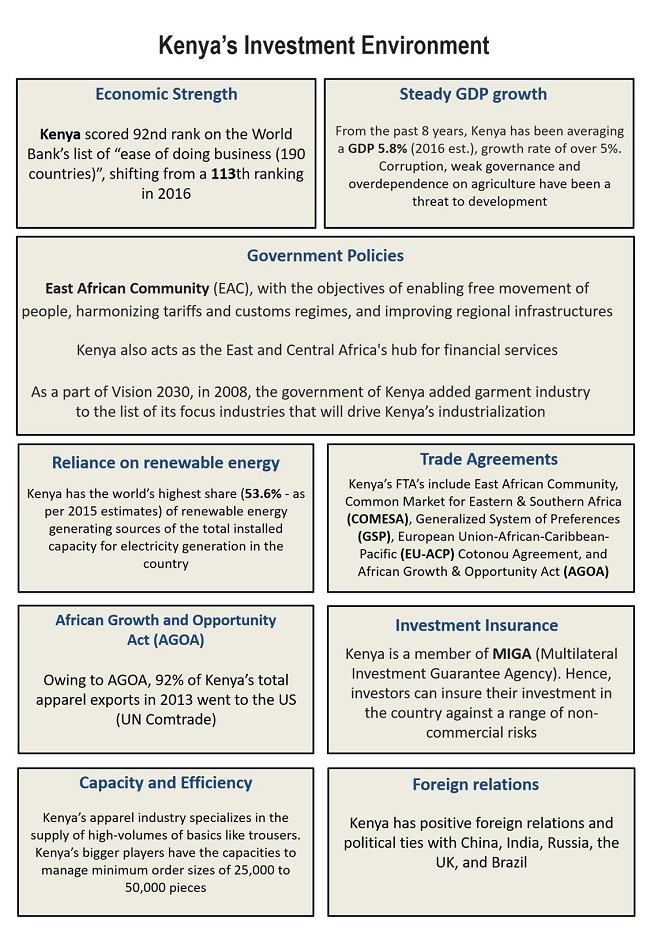Country Overview
The Republic of Kenya is an East African country bordering the Indian Ocean, located between Ethiopia, South Sudan, Uganda, Somalia, and Tanzania. The country is heavily populated, especially along its western region, the capital city of Nairobi, and the southeast region along the Indian Ocean. Kenya has experienced a theatrical population growth since the mid-20th century. It was due to the high birth rate and declining mortality the country experienced.
Challenges faced by the Kenyan Apparel Industry
- Lack of Local Upstream Industry
Due to lack of local upstream industry, Kenyan manufacturers turn to fabric imports to support their operational needs. This results in longer lead times, higher costs and unpredictability within the supply chains. The industry in Kenya needs to embark on the path of vertical integration to experience sustainable growth in the coming years. for overseas manufactured fabrics to come from the abroad and reach the factory, making its way through customs can add up to 40 days in transit to the total order lead time in Kenya.
- Higher Costs
Kenya, when compared to other Sub-Saharan competitors, has higher labor costs. The monthly wage of garment workers in Kenya ranges from $120 to $150. The energy costs in Kenya are also higher, as the power supply is not smooth in the country. The factories thus rely on generators to ensure continuous operations. Power generated by generators is four times the cost of power obtained from a grid in Africa.
- Inefficient Infrastructure
Just like other developing economies, the existing infrastructure is a huge hurdle for the lead-time focused apparel industry in Kenya. Inefficient hard infrastructure, inefficient customs processes, limited capacity of Mombasa port (it cannot serve mother vessels), and prevalence of weighbridges on the roads (adds waiting time for truck transports which accounts for around 94% of the total apparel transports), pose serious challenges to the industry’s lead time and cost efficiencies.
- Compliance Issues:
Kenya needs to address compliance issues to attract more international brands to the country. Corruption, poor social compliance, high crime rates, etc are the major challenges that alienate international buyers from the Kenyan apparel industry.
- Overdependence on AGOA
Kenya’s around 92% of garment exports go to the US, due to the duty-free access advantages it enjoys due to its AGOA membership. Apart from AGOA, Kenya also has European Partnership, which many of its players are still reluctant to take full advantage of. This mainly due to the EU’s preferential agreements with the low-cost Asian countries and the duty-free benefits they get, which makes the competition tougher for Kenyan players. Also, European buyers are much more demanding than their US counterparts. AGOA has always been on short renewal cycle only, and any loss of AGOA would directly and harshly impact the Kenyan apparel industry.
- Limited Availability of Skilled Employees
Kenyan manufacturers are hindered in their capacity expansion efforts due to the skill gap they experience in the technical roles. Employees having education backgrounds from local Kenyan institutes are also generally unfamiliar with the demands of mass production. Thus, the lack of qualified technologists and qualified managers is a huge challenge faced by the industry. Hence, the share of expatriates within in the Kenyan factories is very high, which affects their total labor costs.
Other potential sub-Saharan African Countries as Apparel Sourcing Hub
East African countries have recently gained a lot of attention in the global apparel and textile industry. Governments in these countries are taking steps to develop their domestic industries to ensure they are viewed as potential prospects by international apparel brands. Amongst all the sub-Saharan countries Ethiopia and Kenya are garnering the most interest amongst global apparel buyers. Ethiopia offers cost advantage while Kenya boasts on its higher production efficiency. Although Sub-Saharan countries are still struggling with poor infrastructure, a dearth of technical as well as managerial talent, cumbersome customs processes, and compliance struggles, the future of these countries as apparel and textile hubs is bright owing to their cost and geographical advantages.




















